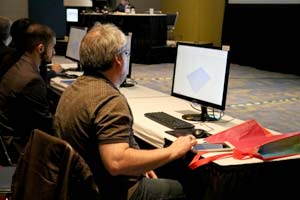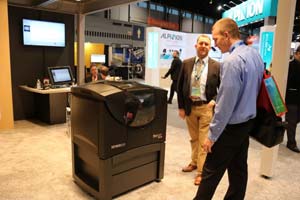Stratasys 3D Printing: Surgical Models Prepare Radiologists for Future Patient Care
3D Printed Surgical Models Prepare Radiologists for Future of Patient Care

Over 600 medical professionals participated in a hands-on workshop to learn how to prepare patient imaging for 3D printing using Materialise software and Stratasys 3D printers.
The Radiological Society of North America (RSNA) Annual Meeting is widely recognized as the country’s largest medical imaging and technology conference. Celebrating its 100th anniversary, the 2015 conference highlighted cutting-edge tools and technologies to aid the radiologist, including Stratasys 3D printing.
A medical application that continued to gain significant momentum at this year’s conference is the use of patient-specific scanning to create 3D printed medical models. Stratasys supported four sold-out workshops lead by Dr. Frank Rybicki of the Ottawa Hospital. The sessions provided hands-on training to over 600 medical professionals from around the world. Participants were trained on how to take patient specific MR and CT imaging, isolate the anatomy of interest, and prepare the files for production on Stratasys 3D printers.
“This is giving doctors powerful tools to take anatomical scans and turn them into 3D prints on Stratasys 3D Printers, so they can plan for success,” said Scott Rader, General Manager, Medical Solutions, Stratasys.

Stratasys Applications Engineer, David Dahl, fields questions about the Objet260 Connex3 3D Printer at the Vital Images booth.
3D printed surgical models have revolutionized the way surgeons prepare for complex surgeries. Using Stratasys’ PolyJet multi-material, multi-color 3D printing technology, surgeons can hold a precise 3D printed replica from a patient scan to understand risks, examine unobstructed views of blood vessels, tumors, or tissues, and optimize surgical procedures to improve operating efficiency and patient outcomes.
The adoption of 3D printing applications across hospitals and institutions has led to collaboration with Stratasys and Vital Images to streamline hospital workflows. RSNA attendees witnessed first-hand how Vital Images’ software can be used to transform 3D images to STL files that can be 3D printed directly on Stratasys 3D Printers.
Additionally, a range of 3D printed medical models derived from Vital Images’ software were presented at both the Vital Images and Stratasys booths and featured models to visualize liver cancer, heart valve calcification, and brain aneurysms.
At the 3D Printing Education Exhibit, attendees had the opportunity to watch a live printing demonstration of a live donor liver transplant model on the Stratasys Objet500 Connex3 3D Printer.
Guests were also welcome to network with the Stratasys Medical Solutions team and members of the medical community. Dr. Frank Rybicki of the Ottawa Hospital, Dr. Jonathan Morris of The Mayo Clinic and Dr. Justin Ryan of Phoenix Children’s Hospital addressed the current and growing trends of 3D printing medical applications.
Click here to see an interview with Scott Rader as he discusses some examples of use cases from hospitals and research institutions from around the globe.
You can also watch our interview with Michael Gaisford, Director of Marketing, Medical Solutions at Stratasys, for a recap of RSNA 2015 highlights. Visit us on Facebook and Instagram for more photos from the conference.

 Blog
Blog